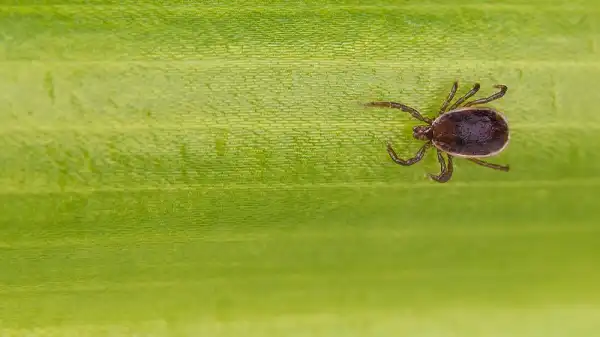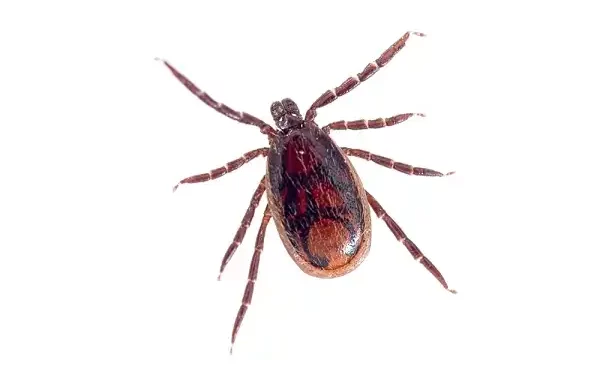Nothing puts a damper on outdoor activities like the discovery of a brown dog tick. Known to transmit several life-threatening diseases, these tiny parasites are something that no pet owner wants to find on their furry family members. While brown dog ticks can cause serious medical issues for both animals and humans, it is important to know how you can prevent them from getting into your home and what treatments are available if needed. In this blog post, we’ll discuss everything related to the brown dog tick: nature and habits, identification methods, prevention/control measures, and treatment options.

Brown Dog Tick Description
The brown dog tick, scientifically known as Rhipicephalus sanguineus, is a small arachnid that is reddish-brown in color and has a flattened, oval-shaped body. One unique characteristic of the brown dog tick is its ability to complete its entire life cycle indoors, allowing it to thrive in homes and kennels. They are commonly found in warm, dry environments such as dog houses, attics, and porches. The tick is equipped with powerful, razor-sharp mouthparts that allow it to feed on the blood of its host. These mouthparts also make removing the tick difficult and sometimes painful.
Brown Dog Tick Habitat
The brown dog tick is known to thrive in warm, dry environments, and can often be found indoors in areas like dog houses, attics, and porches. However, they are not limited to indoor habitats and can also be found outdoors in areas with vegetation. These ticks are not picky when it comes to their hosts and will feed on any mammal they come across. In nature, they are commonly found on wild canids such as coyotes and foxes. They can also be found on domestic dogs and can quickly infest a home or kennel if not properly controlled. It is important to note that brown dog ticks are more commonly found in areas with high temperatures, dry climates, and low humidity. In areas with more humid climates, other tick species tend to dominate. To help prevent brown dog tick infestations, it is important to keep your home and outdoor areas clean and free of debris.
Brown Dog Tick Diet
The brown dog tick is a blood-sucking parasite that feeds on the blood of its host to survive and reproduce. Once a tick has attached itself to its host, it will proceed to feed for several days, often causing intense itching and discomfort for the affected animal. The brown dog tick is particularly adept at feeding on dogs, with its powerful mouthparts allowing it to easily penetrate the skin and suck blood. However, it is not limited to dogs and will also feed on other mammals, including humans, if given the opportunity. While all ticks feed on blood, the exact composition of their diet can vary depending on the species of tick and the host they are feeding on. The brown dog tick, for example, is known to feed exclusively on the blood of its host and does not require any additional nutrients to survive.

Brown Dog Tick Size
The brown dog tick (Rhipicephalus sanguineus) is a small but tenacious parasite that is known to infest dogs and homes worldwide. As a three-host tick, the brown dog tick goes through three life stages: larva, nymph, and adult. Upon hatching, the larva is usually about 0.5 mm long and has 6 legs. After feeding on a host, the larva sheds its skin and turns into a nymph, which has 8 legs. The nymph is about 1 mm in length, and it also feeds on a host before shedding its skin and becoming an adult. The adult tick is typically about 3mm long and has four pairs of legs. In general, adult female brown dog ticks are larger than male ticks. Female ticks can measure up to 5mm in length, while male ticks are usually about 3mm long. After feeding on a host, the female tick can increase in size by as much as ten times her original weight. The male tick also feeds on a host, but it does not increase in size as significantly as the female. It is important to note that the size of the brown dog tick can vary depending on several factors, such as environmental conditions, host availability, and tick population density.
Brown Dog Tick Lifespan
The brown dog tick is a hardy species of parasite that can survive for long periods of time without feeding. This species has a three-stage life cycle, progressing from larva to nymph to adult. In the wild, this tick can live for up to 2 years or longer, depending on environmental conditions and access to hosts. When kept in captivity or confined environments, this species survives an average of 8-10 months before dying off due to a lack of food sources. At each stage of its life cycle, the brown dog tick requires blood meals from a suitable host in order to survive. The most common hosts are dogs and cats, although other animals such as rodents may be used as well. During each of its three life stages, the tick will feed on a host and then molt into the next stage of development. When infesting a home or other environment with suitable hosts, the brown dog tick can rapidly reproduce and form colonies that are difficult to eradicate. In order to prevent large-scale infestations, it is important to take steps such as regular pet check-ups and tick preventatives in order to reduce the risk of ticks entering your home.
Brown Dog Tick Behavior
The brown dog tick is known for its persistent threat to the health of dogs and humans due to its ability to transmit various pathogens. In addition to understanding their life cycle and size, it is equally important to comprehend their behavior to prevent infestations and protect them from tick-borne diseases. Brown dog ticks are active all year round but thrive in warm, arid climates. Unlike other ticks, brown dog ticks are adapted to living in indoor environments such as homes and kennels. They tend to prefer areas that are less cleaned and confined to debris. Additionally, they are well-suited to hiding in cracks and crevices in walls and furniture, increasing the chances of infestations. Moreover, once established, they are hard to eradicate from indoors. Brown dog ticks are highly resilient and can survive for over 200 days without a host, making them a dangerous threat. They are attracted to carbon dioxide produced by mammals and prefer hosts with higher body temperatures. This preference makes dogs an ideal host for the brown dog tick, as their body temperature is higher than humans.

Brown Dog Tick Speed
In addition to understanding the lifespan and behavior of the brown dog tick, it’s equally important to comprehend their speed to better prevent infestations and tick-borne diseases in pets and humans. These parasitic creatures are relatively slow compared to other insects, with an average speed of about 1 meter per hour. However, ticks do not need to be fast to find a host. They rely on a powerful combination of sensory organs to detect carbon dioxide and body heat emitted by nearby animals, which guides them toward their next meal. Once in close proximity to a host, ticks are capable of quickly climbing onto their intended victim, aided by their specialized legs, which are equipped with hooks, allowing them to attach themselves firmly onto fur and skin. While ticks may be relatively slow-moving, they are highly patient creatures. They can remain latched onto a host for extended periods of time, sometimes lasting for days or even weeks before finally dropping off when they have had enough. This patience allows them to feed slowly and efficiently, taking in large amounts of blood and nourishment over a prolonged period.
Brown Dog Tick Hunting
When it comes to brown dog tick hunting, it’s important to note that prevention is key. Taking preventative measures can help reduce the risk of infestations and tick-borne diseases in both pets and humans. One effective prevention method is to regularly inspect pets for signs of ticks, paying close attention to the ears, underbelly, and paws, as these are favorite hiding spots for these parasitic creatures. Additionally, maintaining a clean environment by vacuuming often and keeping outdoor areas tidy can help reduce the number of ticks in the surroundings. Another prevention method is to use tick preventatives, such as topical treatments that are applied to the pet’s skin or oral medications that are taken internally. These treatments work by killing ticks on contact, preventing them from biting and transmitting pathogens to their hosts. While it’s important to take preventative measures, it’s also important to know how to remove ticks properly if one is found. Using tweezers or a tick removal tool, grasp the tick as close to the skin as possible and gently pull it straight out, without twisting or squeezing. It’s important not to crush the tick or leave any parts of it behind, as this can increase the risk of infection.
Brown Dog Tick Prevention and Control Measures
When it comes to controlling brown dog ticks, prevention is key. To reduce the risk of infestations and tick-borne disease, it’s important to take measures such as routinely checking pets for signs of ticks, maintaining clean environments, and using preventative treatments like topical or oral medications. Additionally, it’s important to know how to properly remove a tick if one is found and be aware of the signs and symptoms of tick-borne illness. By taking these precautions, we can help keep ourselves and our furry friends safe from these pesky parasites. By staying vigilant and knowledgeable about brown dog ticks, we can effectively protect ourselves, our pets, and those around us from the risks associated with these parasitic creatures. With proper prevention methods and by exercising awareness, we can help reduce the risk of infestations and tick-borne diseases. With this knowledge, we can keep ourselves, our pets, and those around us safe from the dangers associated with brown dog ticks.

Conclusion
The brown dog tick is a small but powerful parasite that can cause serious health problems if left unchecked. They exhibit patience and agility, allowing them to feed slowly on their hosts and quickly move to new locations when needed. While prevention is key when it comes to brown dog ticks, it’s also important to know how to properly remove them and recognize the signs of tick-borne illness. By taking the appropriate steps, we can help reduce the risk of infestations and keep ourselves and our loved ones safe from these pests. While the brown dog tick may appear to be slow in comparison with other species, they are highly patient creatures that have adapted pronounced behaviors for hunting.
Frequently Asked Question

